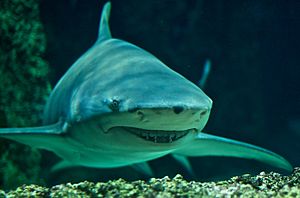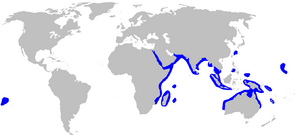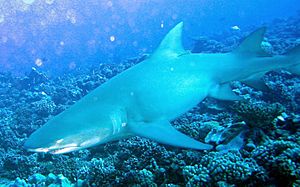Sicklefin lemon shark facts for kids
Quick facts for kids Sicklefin lemon shark |
|
|---|---|
 |
|
| A Sicklefin lemon shark at the Sydney Aquarium. | |
| Conservation status | |
| Scientific classification | |
| Kingdom: | |
| Phylum: | |
| Class: | |
| Order: | |
| Family: | |
| Genus: | |
| Species: |
N.acutidens
|
| Binomial name | |
| Negaprion acutidens (Rüppell, 1837)
|
|
 |
|
| Range of the Sicklefin lemon shark | |
The sicklefin lemon shark (Negaprion acutidens) is also called the sharptooth lemon shark. It is a type of requiem shark found in warm, tropical waters of the Indo-Pacific region. This shark is a close relative of the more famous lemon shark found in the Americas.
These two shark species look very much alike. Both are strong, have wide heads, and two dorsal fins (back fins) that are almost the same size. They also have a plain yellowish color. The sicklefin lemon shark gets its name because its fins are shaped like a sickle, which is a curved farming tool. This large shark can grow up to 3.8 m (12 ft) long. It usually lives in water less than 92 m (302 ft) deep. You can find it in many places, from mangrove estuaries to coral reefs.
The sicklefin lemon shark is a slow-moving predator. It mostly eats bony fishes. This shark does not travel far. Many of them stay in the same areas all year. Like other sharks in its family, the female sicklefin lemon shark gives birth to live young. She can have up to 13 pups every two years. Her pregnancy lasts about 10 to 11 months.
Sicklefin lemon sharks can be dangerous if they are bothered. But normally, they are careful and will swim away if people get too close. The IUCN says this shark is a Vulnerable species. This means its numbers are going down. They do not have many babies, and they do not move around much. This makes it hard for their populations to grow back if too many are caught. In places like India and Southeast Asia, many of these sharks have been caught. People use them for their meat, fins, and liver oil.
Contents
Where Sicklefin Lemon Sharks Live
The sicklefin lemon shark lives in a wide area. Its range goes from South Africa to the Red Sea. This includes places like Mauritius, the Seychelles, and Madagascar. It then stretches east along the coast of India to Southeast Asia. You can find it as far north as Taiwan and the Philippines. It also goes south to New Guinea and northern Australia.
These sharks are also found around many Pacific islands. Some of these islands include New Caledonia, Palau, the Marshall Islands, the Solomon Islands, Fiji, Vanuatu, and French Polynesia. Scientists think these sharks spread across the central Pacific by swimming from one island to the next. Sharks in Australia and French Polynesia, which are 750 km (470 mi) apart, are a bit different genetically. This means they do not mix much between these areas.
This shark lives near the coast on continental and island shelves. You can find it from the shallowest parts of the ocean to about 92 m (302 ft) deep. It likes calm, cloudy waters. It is most common in bays, estuaries, and lagoons. They also like sandy areas and outer reefs. Sometimes, a shark might swim into the open ocean. One was even filmed near a dead sperm whale in a 1971 movie.
Young sicklefin lemon sharks often live on reef flats or near mangroves. The water there is so shallow that their dorsal fins stick out. In Herald Bight, off Western Australia, young sharks hang out in open areas and mangroves. The water is less than 3 m (9.8 ft) deep there. This area is known as a nursery for them.
What Sicklefin Lemon Sharks Look Like
The sicklefin lemon shark has a strong, thick body. Its head is short and wide. Its snout is rounded or slightly pointed. It has small nostrils with triangle-shaped skin flaps in front. Its eyes are small, and it does not have spiracles (small holes behind the eyes). There are short grooves at the corners of its mouth.
This shark has 13 to 16 (usually 14) rows of teeth on each side of both jaws. This does not include the tiny teeth in the middle of the jaw. The upper teeth have a large point coming from a wide base. They have a notch on each side. These teeth become more angled towards the corners of the mouth. The lower teeth look like the upper teeth but are thinner and stand up straighter. Sharks longer than 1.4 m (4.6 ft) have finely serrated (saw-like) teeth.
The fins of the sicklefin lemon shark are more curved, or sickle-shaped, than those of the American lemon shark. This is true for its dorsal (back), pectoral (side), and pelvic (bottom) fins. The first dorsal fin is closer to the pelvic fins than the pectoral fins. The second dorsal fin is almost the same size as the first. It is located above or slightly in front of the anal fin (bottom fin near the tail). There is no ridge between the dorsal fins. The pectoral fins are long and wide. The anal fin has a deep notch at the back.
The shark's skin is covered in small, overlapping dermal denticles. Each denticle has three to five ridges. The shark's color is a plain yellowish-brown or gray on top. Its underside is lighter, and its fins are more yellow. This species can grow up to 3.8 m (12 ft) long. However, it usually does not get bigger than 3.1 m (10 ft).
Life and Habits
The sicklefin lemon shark is a slow-moving animal. You often see it swimming calmly just above the sea floor or resting still on it. Unlike most requiem sharks, it can actively pump water over its gills. This means it does not have to keep swimming to breathe. But it will swim to the surface if it is chasing food.
This shark rarely travels long distances. A study in the Seychelles found that over 90% of tagged sharks were still within 2 km (1.2 mi) of where they were first tagged. Another study in French Polynesia showed that some sharks lived there all year. Others just visited sometimes.
More than 90% of what the sicklefin lemon shark eats is teleost fish. These are fish that live near the bottom or shore. They include herring, mullets, mackerel, silversides, needlefish, smelt-whitings, porgies, sea catfish, triggerfish, parrotfish, and porcupinefish. Sometimes, they might also eat cephalopods (like squid) and crustaceans (like crabs). Older sharks have been known to eat stingrays and guitarfish. Larger sharks might hunt the sicklefin lemon shark.
Sicklefin lemon sharks have been seen resting on the bottom and letting cleaner fish clean them. These cleaner fish are called bluestreak cleaner wrasses. The shark might open its mouth and stop breathing for up to 150 seconds. This lets the wrasses clean inside its mouth and gills.
Reproduction and Life Cycle
Like other sharks in its family, the sicklefin lemon shark gives birth to live young. The baby sharks grow inside the mother. They get food from a placenta that forms from their yolk sacs. Females give birth to 1 to 13 pups (usually 6 to 12) every two years. They have their babies in shallow nursery areas. The pregnancy lasts 10 to 11 months.
Unlike the American lemon shark, there is not much proof that this species returns to the exact place where they were born to have their own babies. Births happen in October or November in Madagascar and Aldabra. In French Polynesia, they happen in January. Non-pregnant females mate and lay eggs around the same time.
The baby sharks develop a placenta after about four months of pregnancy. At this time, they still have small parts of external gills. The young are born at a length of 45–80 cm (18–31 in). Young sharks grow slowly, about 12.5–15.5 cm (4.9–6.1 in) each year. Both male and female sharks become able to have babies when they are about 2.2–2.4 m (7.2–7.9 ft) long.
Images for kids
-
A Sicklefin lemon shark at the Sydney Aquarium.
See also
 In Spanish: Cazón negrudo para niños
In Spanish: Cazón negrudo para niños












